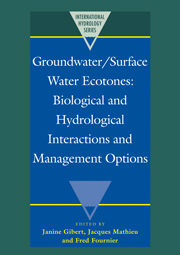Book contents
- Frontmatter
- Contents
- List of authors
- Preface
- I INTRODUCTION
- II FUNCTION OF GROUNDWATER / SURFACE WATER INTERFACES
- 2 Ecotonal animal assemblages; their interest for groundwater studies
- 3 Stochasticity in resource utilization by a larval chironomidae (diptera) community in the bed sediments of a gravel stream
- 4 Temporal and spatial dynamics of meiofaunal assemblages in the hyporheic interstitial of a gravel stream
- 5 Interstitial fauna along an epigean-hypogean gradient in a Rocky Mountain river
- 6 Filter effect of karstic spring ecotones on the population structure of the hypogean amphipod Niphargus virei
- 7 Community respiration in the hyporheic zone of a riffle-pool sequence
- 8 Diversity, connectivity and variability of littoral, surface water ecotones in three side arms of the Szigetköz region (Danube, Hungary)
- 9 Seasonal dynamics and storage of particulate organic matter within bed sediment of three streams with contrasted riparian vegetation and morphology
- 10 Bedsediments: Protein and POM content (RITRODAT-Lunz study area, Austria)
- 11 Dynamics and vertical distribution of particulate organic matter in river bed sediments (Morava River, Czech Republic)
- 12 Surface water/groundwater/forest alluvial ecosystems: functioning of interfaces. The case of the Rhine floodplain in Alsace (France)
- 13 Modelling of hydrological processes in a floodplain wetland
- 14 Contribution to the groundwater hydrology of the Amboseli ecosystem, Kenya
- 15 The role of hydrology in defining a groundwater ecosystem
- 16 Typology of water transport and chemical reactions in groundwater/lake ecotones
- 17 Development of a water transfer equation for a groundwater/surface water interface and use of it to forecast floods in the Yanghe Reservoir Basin
- 18 Uses and limitations of ground penetrating RADAR in two riparian systems
- III MALFUNCTION OF GROUNDWATER / SURFACE WATER INTERFACES: CAUSES AND METHODS OF EVALUATION
- IV MANAGEMENT AND RESTORATION OF GROUNDWATER / SURFACE WATER INTERFACES
- V CONCLUSION
- ANNEX
15 - The role of hydrology in defining a groundwater ecosystem
Published online by Cambridge University Press: 07 September 2010
- Frontmatter
- Contents
- List of authors
- Preface
- I INTRODUCTION
- II FUNCTION OF GROUNDWATER / SURFACE WATER INTERFACES
- 2 Ecotonal animal assemblages; their interest for groundwater studies
- 3 Stochasticity in resource utilization by a larval chironomidae (diptera) community in the bed sediments of a gravel stream
- 4 Temporal and spatial dynamics of meiofaunal assemblages in the hyporheic interstitial of a gravel stream
- 5 Interstitial fauna along an epigean-hypogean gradient in a Rocky Mountain river
- 6 Filter effect of karstic spring ecotones on the population structure of the hypogean amphipod Niphargus virei
- 7 Community respiration in the hyporheic zone of a riffle-pool sequence
- 8 Diversity, connectivity and variability of littoral, surface water ecotones in three side arms of the Szigetköz region (Danube, Hungary)
- 9 Seasonal dynamics and storage of particulate organic matter within bed sediment of three streams with contrasted riparian vegetation and morphology
- 10 Bedsediments: Protein and POM content (RITRODAT-Lunz study area, Austria)
- 11 Dynamics and vertical distribution of particulate organic matter in river bed sediments (Morava River, Czech Republic)
- 12 Surface water/groundwater/forest alluvial ecosystems: functioning of interfaces. The case of the Rhine floodplain in Alsace (France)
- 13 Modelling of hydrological processes in a floodplain wetland
- 14 Contribution to the groundwater hydrology of the Amboseli ecosystem, Kenya
- 15 The role of hydrology in defining a groundwater ecosystem
- 16 Typology of water transport and chemical reactions in groundwater/lake ecotones
- 17 Development of a water transfer equation for a groundwater/surface water interface and use of it to forecast floods in the Yanghe Reservoir Basin
- 18 Uses and limitations of ground penetrating RADAR in two riparian systems
- III MALFUNCTION OF GROUNDWATER / SURFACE WATER INTERFACES: CAUSES AND METHODS OF EVALUATION
- IV MANAGEMENT AND RESTORATION OF GROUNDWATER / SURFACE WATER INTERFACES
- V CONCLUSION
- ANNEX
Summary
ABSTRACT Based on two years of observations in a small aquifer in the Danube old arm system (near Vienna), the dynamics of a groundwater ecosystem is analyzed. The results show that differences in the oxygen concentration and the distribution pattern of the meiofauna community are a consequence of seasonal variations of the water level in the old arms. The water level as a boundary condition and also temperature are two important factors that govern the interaction processes between groundwater and surface water. In periods of flood events these interaction processes can achieve greater proportions, giving rise to temporary alterations in the ecosystem. Low water periods inhibit partially the infiltration of surface water into the aquifer.
INTRODUCTION
The delineation of a groundwater (GW) ecosystem within an unconsolidated geological formation is of paramount interest for both basic and applied research (Stanford & Ward, 1992). To perceive the subsurface environment, well defined systems are required. An ecological system consists of both abiotic and biotic components that exchange closely information and/or matter between them (Jordan, 1981). The ecologists dealing with the study of aquatic subsurface environments in porous media had persistent difficulties in defining ecological systems, which should represent more than simple definitions. Danielopol (1980) suggested that beside biological criteria ecologists should also use hydrological ones in order to define an ecological system. Such an approach was pioneered in the 1960s and 1970s by R. Rouch and A. Mangin when they studied the Baget karst system in southern France (see review in Mangin, 1976; Rouch, 1986). Danielopol (1989) showed that for the study of a porous system one of the most appropriate ecological unit should be a well defined aquifer.
- Type
- Chapter
- Information
- Groundwater/Surface Water EcotonesBiological and Hydrological Interactions and Management Options, pp. 119 - 126Publisher: Cambridge University PressPrint publication year: 1997
- 6
- Cited by

